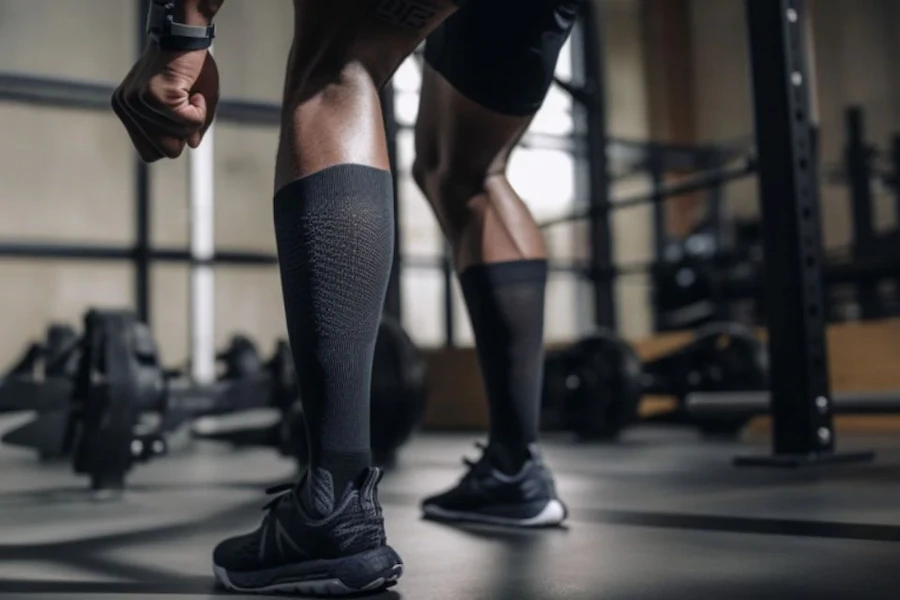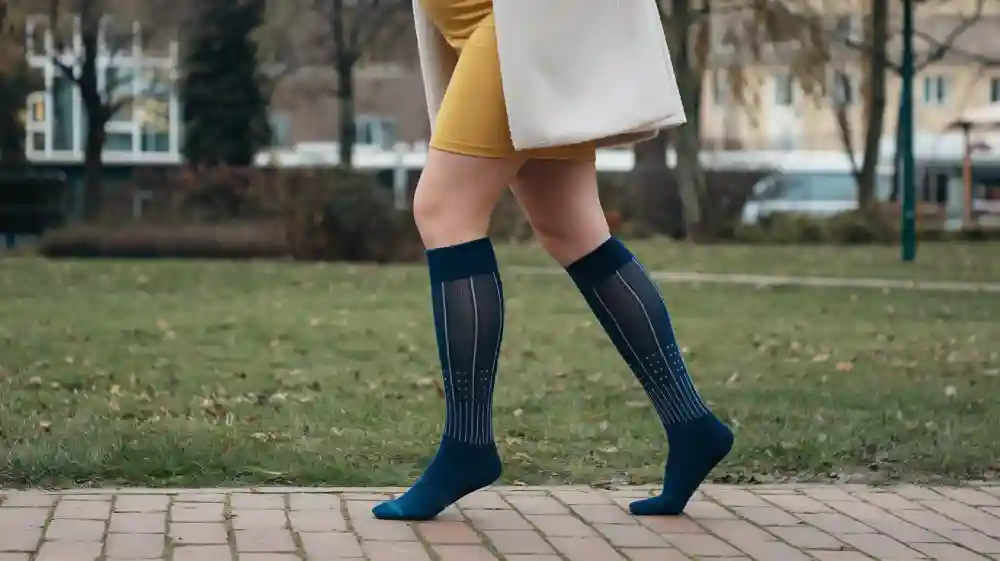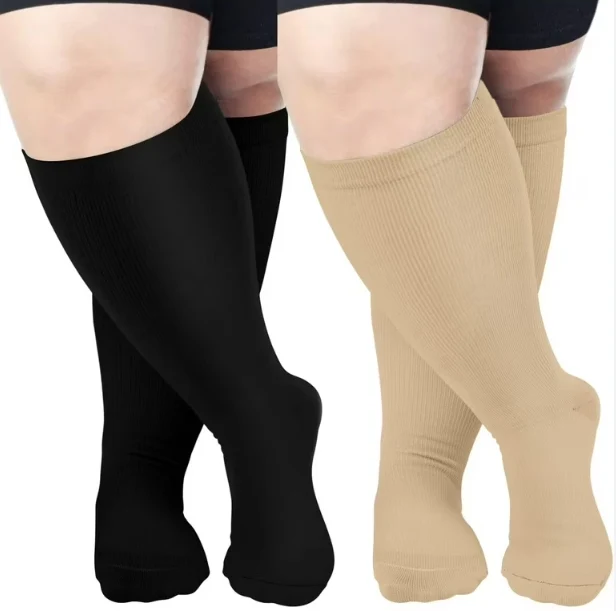Introduction
Finding the right fit for compression socks is more important than you might think. If they’re too tight, they can cause discomfort and even affect circulation, leading to potential health issues. On the other hand, if they’re too loose, they won’t provide the benefits your customers are looking for. For brands and retailers, understanding the balance between compression and comfort is key to providing a product that works.
Yes, compression socks can be dangerously too tight. Instead of a supportive hug, they’ll feel pain and may restrict circulation—the very thing they’re meant to improve. Watch for signs like numbness, skin discoloration, or deep indentations. Accurate calf and ankle measurement is crucial for a safe and effective fit.
In this article, we’ll break down why tightness matters, how to recognize if compression socks are too tight, and what you can do to ensure you’re offering the right fit for your customers. By getting it right, you’ll help your customers feel their best and ensure they get the most out of their compression socks.

How Compression Socks Work (And Why Fit Is Critical)
Compression socks, such as custom graduated running compression socks for OEM and private label brands, are designed to provide targeted pressure to the legs, improving circulation and supporting muscle recovery. They come in various compression levels, typically measured in mmHg (millimeters of mercury). For everyday use, socks with lower compression, like 10-20 mmHg, offer general comfort and relief from fatigue. Medical-grade compression, such as 20-30 mmHg or higher, is often used to treat specific conditions, like varicose veins or deep vein thrombosis.
The right level of tightness is essential because it helps blood flow more efficiently, reducing swelling and supporting recovery after exercise. However, when compression becomes too tight, it can have the opposite effect, restricting circulation and causing discomfort. This is why understanding how tightness affects the body is crucial for both performance and health.
What Happens When Compression Socks Are Too Tight?
When compression socks feel too tight and start to affect circulation—here’s why your legs ache, which is their primary purpose. Instead of helping blood flow, overly tight socks can restrict it, leading to discomfort and even pain. Instead of helping blood flow, overly tight socks can restrict it, leading to discomfort and even pain. As the fabric squeezes too much, blood vessels may become compressed, making it harder for the heart to pump blood back up from the legs. This can result in swelling, a feeling of heaviness, or numbness in the feet and legs.
Aside from discomfort, the health risks of wearing overly tight compression socks are significant. In the worst cases, it can cause blood clots or exacerbate existing circulation problems. For customers with pre-existing conditions, like diabetes or varicose veins, wearing socks that are too tight can worsen their symptoms. It’s crucial to ensure that compression socks are comfortable and fit properly to avoid these potential complications.
How to Identify If Compression Socks Are Too Tight
It’s important to check if your compression socks are the right fit to ensure they are working effectively without causing harm. Here are a few signs to look out for to make sure your socks aren’t too tight.
5 Signs That Your Compression Socks Are Too Tight

- Visible Indentations or Marks – If you notice deep lines, indentations or skin color changes ( such as white, red, or blue ) on your skin after removing the socks, it may be a sign that they are too tight.
- Swelling or Numbness – Excessive tightness can restrict blood flow, leading to swelling in your feet or legs. Numbness or a tingling sensation can also occur.
- Pain or Discomfort – If your compression socks cause pain, especially in the calves, feet, or ankles, they may be applying too much pressure.
- Difficulty Putting Them On or Taking Them Off – If putting on or removing your compression socks is a struggle, they might be too small or tight for your body.
- Leg Heaviness or Fatigue – While compression socks are meant to reduce fatigue, if they are too tight, they can cause a heavy or tired feeling in the legs, making movement uncomfortable.
How to Check for Discomfort or Restricted Blood Flow
To assess whether the fit is too tight, start by checking for any physical signs like redness, irritation, or marks on the skin. You should also pay attention to how your legs feel throughout the day. If they start feeling numb, cold, or overly fatigued, it could be a sign that the compression socks are restricting blood flow.
It’s crucial to find a balance between compression and comfort. A snug fit is ideal, but it should never cause pain or discomfort. Testing the fit with these simple checks can help ensure your customers enjoy all the benefits without any negative side effects.
Can Compression Socks Be Too Tight for Specific Conditions?
Compression socks can be helpful, but it’s important to consider certain health conditions when choosing the right fit.
Safety Considerations for People with Diabetes or Poor Circulation
People with diabetes or poor circulation need to be careful when wearing compression socks. If the socks are too tight, they can restrict blood flow, which can make circulation problems worse. It’s best to choose socks with lower compression (around 10–20 mmHg), such as 10–20 mmHg compression socks optimized for daily wear and long shifts, to avoid these risks. A proper fit is essential to help improve circulation without causing discomfort or harm (source: Cleveland Clinic).
Are Compression Socks Safe During Pregnancy?
Pregnant women often experience leg swelling, and compression socks can help. However, wearing socks that are too tight can restrict blood flow and cause more discomfort. A moderate compression level (15-25 mmHg) is usually recommended during pregnancy, but it’s important to ensure the socks are not too tight around the calves or ankles. Pregnant customers should consult their doctor to make sure they choose the right fit for their needs (source: March of Dimes).
How to Choose the Right Compression Sock Fit
Choosing the right fit is crucial to getting the full benefits of compression socks without causing discomfort or harm. Here’s how to make sure you pick the best option for your customers.
Finding the Ideal Compression Level for Comfort and Effectiveness
The ideal compression level depends on your customers’ needs. Compression socks come in different pressure levels, typically measured in mmHg. For general comfort, socks with 10-20 mmHg are usually best. This level helps with fatigue and swelling without being too tight. For medical conditions like varicose veins or deep vein thrombosis, higher compression levels (20-30 mmHg) may be necessary.
Make sure to consider the purpose of the socks—whether it’s for daily wear, exercise recovery, or medical use—and recommend the appropriate level of compression for each situation.

Tips for Selecting the Best Compression Socks Based on Your Needs
When selecting compression socks, consider the following tips:
- Know the Intended Use: For everyday wear, moderate compression (15-25 mmHg) is often ideal, while higher levels may be needed for specific medical conditions.
- Check the Sizing Chart: Proper sizing is key. Be sure to measure the leg and ankle circumference to ensure the socks fit well and offer the right amount of pressure.
- Comfort Is Key: The socks should provide support but should not cause discomfort. Test the fit to make sure no pinching or tightness could affect circulation.
By understanding your customers’ needs and preferences, you can help them choose the right compression socks for their comfort and health.
Proper Wear and Adjustment of Compression Socks
Wearing compression socks correctly is just as important as choosing the right fit. Follow these guidelines to ensure your customers get the most out of their socks. Learn more about proper wear from the National Library of Medicine.
How to Put On and Adjust Compression Socks for Maximum Comfort
Putting on compression socks may feel a bit tricky at first, but with the right approach, it becomes easier. Here’s how to do it properly:
- Roll them down: Start by rolling the socks down to the toe area, then slide your foot in. This makes it easier to pull the sock up without bunching.
- Pull up slowly: Gently pull the sock up your leg, making sure it’s smooth with no wrinkles. Adjust it gradually to ensure even compression across the entire leg.
- Position correctly: The socks should sit comfortably without pinching. Make sure the top edge isn’t rolling down, and the sock fits snugly without cutting off circulation.
Read our step-by-step guide on how to put on compression socks for more help.
Common Mistakes to Avoid and How to Avoid Them
Here are a few common mistakes to watch out for:
- Pulling too hard: Overstretching compression socks can damage the fabric and reduce their effectiveness. Instead, take your time and gradually pull them on.
- Wearing them too loosely: If the socks are too loose, they won’t provide the necessary pressure. Ensure the socks are snug but not painfully tight.
- Not adjusting regularly: Throughout the day, it’s important to check that the socks haven’t slipped or become bunched up, as this can affect their performance.
By following these steps, you can help your customers wear their compression socks correctly, ensuring maximum comfort and effectiveness.
What to Do If Compression Socks Feel Too Tight
If compression socks feel too tight, it’s crucial to take the proper steps to avoid discomfort or potential health issues. Here’s what you can do if the fit isn’t right.
Steps to Take If You Experience Discomfort or Health Issues
- Remove the Socks: If the socks are causing discomfort, or you’re feeling numb or tingly sensations, take them off immediately to relieve the pressure.
- Check the Fit: After removing the socks, look for any marks or indentations on your skin. These could be signs that the socks were too tight. If you notice such marks, the fit may need to be adjusted.
- Adjust the Size: Re-measure the size of the legs, including the thinnest part of the ankle, the thickest part of the calf, and the thigh circumference if you’re using thigh-high socks. Based on these measurements, refer to the size chart to select the appropriate sock size. For those with thicker calves, consider choosing a style with a wider calf for a better fit.
- Change the Compression Level: If the current socks feel too tight, try switching to a different compression level. For general health and daily comfort, mild compression socks (8-15 mmHg) can be a great option. For conditions like preventing deep vein thrombosis, moderate compression socks (15-20 mmHg) may be more suitable. Be sure to select the right compression level based on your needs.

When to Consult a Medical Professional
If discomfort continues or if you experience unusual symptoms like persistent pain, swelling, or redness, it’s time to consult a healthcare provider. A medical professional can assess your situation and recommend the best options for your needs.
This is especially important for individuals with pre-existing conditions such as diabetes, varicose veins, or poor circulation, as they may require specific compression levels to ensure both safety and effectiveness.
Conclusion
Getting the right fit for compression socks is key to ensuring comfort and improving circulation. Whether your customers need them for everyday wear, health reasons, or sports recovery, choosing the right size and compression level is essential for effectiveness.
If you’re a brand or retailer looking to offer the best compression socks, make sure you understand your customers’ needs and help them find the perfect fit. If you’re interested in customizing compression socks for your brand, contact us today. Let’s work together to create high-quality products that your customers will love.
FAQs
Can compression socks be used for all types of activities?
Yes, compression socks are versatile and can be used for various activities, including sports, long hours of standing, or even daily wear for better circulation. The key is choosing the right compression level for each activity.
What are the benefits of offering custom compression socks to my customers?
Custom compression socks can enhance your brand’s identity and provide a tailored experience for your customers. Offering unique designs, colors, and sizes helps set your products apart and ensures customer satisfaction.
How long do compression socks last?
With proper care, compression socks can last for months. We ensure durability by using high-quality materials and precise manufacturing processes. Customers should follow care instructions to maintain their socks’ effectiveness.
Can compression socks be used for both men and women?
Yes, compression socks are available in various sizes and designs for both men and women. We offer custom sizing to ensure a perfect fit for all customers.
What sizes do you offer for compression socks?
We offer a wide range of sizes, from small to extra-large, ensuring a perfect fit for your customers. Custom sizing options are also available to meet specific needs or accommodate unique requirements.
